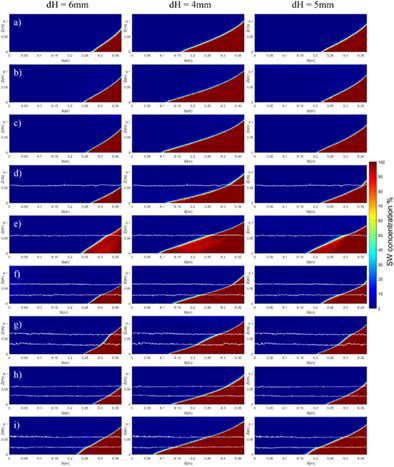当前位置:
X-MOL 学术
›
Hydrol. Process.
›
论文详情
Our official English website, www.x-mol.net, welcomes your feedback! (Note: you will need to create a separate account there.)
The impact of aquifer stratification on saltwater intrusion characteristics. Comprehensive laboratory and numerical study
Hydrological Processes ( IF 3.2 ) Pub Date : 2021-03-12 , DOI: 10.1002/hyp.14120 Georgios Etsias 1 , Gerard A. Hamill 1 , Jesús F. Águila 1 , Eric M. Benner 1 , Mark C. McDonnell 1 , Ashraf A. Ahmed 2 , Raymond Flynn 1
Hydrological Processes ( IF 3.2 ) Pub Date : 2021-03-12 , DOI: 10.1002/hyp.14120 Georgios Etsias 1 , Gerard A. Hamill 1 , Jesús F. Águila 1 , Eric M. Benner 1 , Mark C. McDonnell 1 , Ashraf A. Ahmed 2 , Raymond Flynn 1
Affiliation

|
Laboratory experiments and numerical simulations were utilized in this study to assess the impact of aquifer stratification on saltwater intrusion. Three homogeneous and six layered aquifers were investigated. Image processing algorithms facilitated the precise calculation of saltwater wedge toe length, width of the mixing zone, and angle of intrusion. It was concluded that the length of intrusion in stratified aquifers is predominantly a function of permeability contrast, total aquifer transmissivity and the number of heterogeneous layers, being positively correlated to all three. When a lower permeability layer overlays or underlays more permeable zones its mixing zone widens, while it becomes thinner for the higher permeability strata. The change in the width of the mixing zone (WMZ) is positively correlated to permeability contrast, while it applies to all strata irrespectively of their relative vertical position in the aquifer. Variations in the applied hydraulic head causes the transient widening of WMZ. These peak WMZ values are larger during saltwater retreat and are negatively correlated to the layer's permeability and distance from the aquifer's bottom. Moreover, steeper angles of intrusion are observed in cases where low permeability layers overlay more permeable strata, and milder ones in the inverse aquifer setups. The presence of a low permeability upper layer results in the confinement of the saltwater wedge in the lower part of the stratified aquifer. This occurs until a critical hydraulic head difference is applied to the system. This hydraulic gradient value was found to be a function of layer width and permeability contrast alike.
中文翻译:

含水层分层对盐水入侵特征的影响。综合实验室和数值研究
本研究利用实验室实验和数值模拟来评估含水层分层对盐水入侵的影响。研究了三个均质层和六个层状含水层。图像处理算法有助于精确计算盐水楔形趾的长度,混合区域的宽度和侵入角度。结论是,分层含水层中的侵入长度主要是渗透率对比,总含水层透射率和非均质层数的函数,与这三者均呈正相关。当较低渗透率的层覆盖或覆盖较高渗透率的区域时,其混合区变宽,而对于较高渗透率的地层,其混合区变薄。混合区宽度(WMZ)的变化与渗透率对比度呈正相关,而它适用于所有地层,无论其在含水层中的相对垂直位置如何。所施加的液压压头的变化会引起WMZ的瞬态加宽。这些峰值WMZ值在盐水撤退期间较大,并且与该层的渗透性和与含水层底部的距离呈负相关。此外,在低渗透层覆盖更多渗透层的情况下,观察到较陡的侵入角,而在反含水层设置中观察到较缓的侵入角。低渗透性上层的存在导致盐水楔在层状含水层下部的封闭。直到发生关键的液压压差差,系统才会发生这种情况。发现该水力梯度值是层宽和渗透率对比的函数。
更新日期:2021-04-29
中文翻译:

含水层分层对盐水入侵特征的影响。综合实验室和数值研究
本研究利用实验室实验和数值模拟来评估含水层分层对盐水入侵的影响。研究了三个均质层和六个层状含水层。图像处理算法有助于精确计算盐水楔形趾的长度,混合区域的宽度和侵入角度。结论是,分层含水层中的侵入长度主要是渗透率对比,总含水层透射率和非均质层数的函数,与这三者均呈正相关。当较低渗透率的层覆盖或覆盖较高渗透率的区域时,其混合区变宽,而对于较高渗透率的地层,其混合区变薄。混合区宽度(WMZ)的变化与渗透率对比度呈正相关,而它适用于所有地层,无论其在含水层中的相对垂直位置如何。所施加的液压压头的变化会引起WMZ的瞬态加宽。这些峰值WMZ值在盐水撤退期间较大,并且与该层的渗透性和与含水层底部的距离呈负相关。此外,在低渗透层覆盖更多渗透层的情况下,观察到较陡的侵入角,而在反含水层设置中观察到较缓的侵入角。低渗透性上层的存在导致盐水楔在层状含水层下部的封闭。直到发生关键的液压压差差,系统才会发生这种情况。发现该水力梯度值是层宽和渗透率对比的函数。



























 京公网安备 11010802027423号
京公网安备 11010802027423号